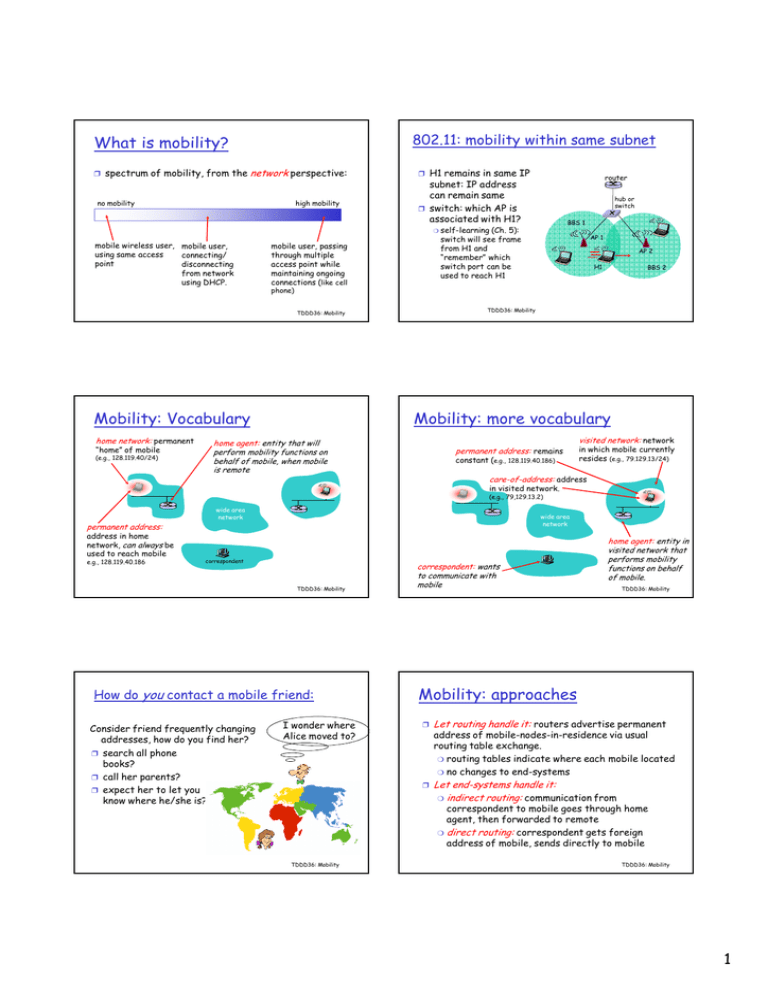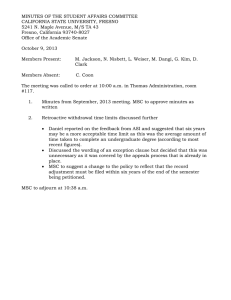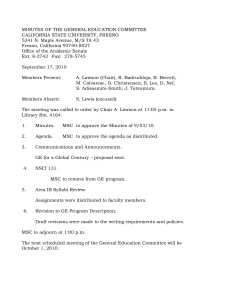What is mobility? 802.11: mobility within same subnet
advertisement

802.11: mobility within same subnet What is mobility? ❒ spectrum of mobility, from the network perspective: no mobility high mobility ❒ H1 remains in same IP ❍ mobile wireless user, mobile user, using same access connecting/ point disconnecting from network using DHCP. router subnet: IP address can remain same ❒ switch: which AP is associated with H1? mobile user, passing through multiple access point while maintaining ongoing connections (like cell hub or switch BBS 1 self-learning (Ch. 5): switch will see frame from H1 and “remember” which switch port can be used to reach H1 AP 1 AP 2 H1 BBS 2 phone) TDDD36: Mobility TDDD36: Mobility Mobility: more vocabulary Mobility: Vocabulary home network: permanent “home” of mobile (e.g., 128.119.40/24) home agent: entity that will perform mobility functions on behalf of mobile, when mobile is remote permanent address: remains constant (e.g., 128.119.40.186) visited network: network in which mobile currently resides (e.g., 79.129.13/24) care-of-address: address in visited network. (e.g., 79,129.13.2) wide area network wide area network permanent address: address in home network, can always be used to reach mobile e.g., 128.119.40.186 correspondent TDDD36: Mobility How do you contact a mobile friend: Consider friend frequently changing addresses, how do you find her? ❒ search all phone books? ❒ call her parents? ❒ expect her to let you know where he/she is? I wonder where Alice moved to? correspondent: wants to communicate with mobile home agent: entity in visited network that performs mobility functions on behalf of mobile. TDDD36: Mobility Mobility: approaches ❒ Let routing handle it: routers advertise permanent address of mobile-nodes-in-residence via usual routing table exchange. ❍ routing tables indicate where each mobile located ❍ no changes to end-systems ❒ Let end-systems handle it: ❍ indirect routing: communication from correspondent to mobile goes through home agent, then forwarded to remote ❍ direct routing: correspondent gets foreign address of mobile, sends directly to mobile TDDD36: Mobility TDDD36: Mobility 1 Mobility: approaches ❒ Mobility: registration visited network home network Let routing handle it: routers advertise permanent not address of mobile-nodes-in-residence via usual scalable routing table exchange. to millions of ❍ routing tables indicate mobiles where each mobile located ❍ no changes to end-systems ❒ 1 2 wide area network let end-systems handle it: ❍ indirect routing: communication from mobile contacts foreign agent on entering visited network foreign agent contacts home agent home: “this mobile is resident in my network” correspondent to mobile goes through home agent, then forwarded to remote ❍ direct routing: correspondent gets foreign address of mobile, sends directly to mobile End result: ❒ Foreign Agent (FA) knows about mobile ❒ Home Agent (HA) knows location of mobile TDDD36: Mobility Mobility via Indirect Routing Indirect Routing: comments foreign agent receives packets, forwards to mobile home agent intercepts packets, forwards to foreign agent home network ❒ Mobile uses two addresses: 3 1 permanent address: used by correspondent (hence mobile location is transparent to correspondent) ❍ care-of-address: used by home agent to forward datagrams to mobile ❒ foreign agent functions may be done by mobile itself ❒ triangle routing: correspondent-home-networkmobile ❍ inefficient when correspondent, mobile are in same network ❍ visited network wide area network correspondent addresses packets using home address of mobile TDDD36: Mobility 2 4 mobile replies directly to correspondent TDDD36: Mobility Indirect Routing: moving between networks TDDD36: Mobility Mobility via Direct Routing ❒ suppose mobile user moves to another network registers with new foreign agent ❍ new foreign agent registers with home agent ❍ home agent update care-of-address for mobile ❍ packets continue to be forwarded to mobile (but with new care-of-address) correspondent forwards to foreign agent ❍ ❒ mobility, changing foreign networks transparent: ongoing connections can be maintained! TDDD36: Mobility foreign agent receives packets, forwards to mobile home network 4 wide area network 2 correspondent requests, receives foreign address of mobile visited network 1 3 4 mobile replies directly to correspondent TDDD36: Mobility 2 Mobility via Direct Routing: comments ❒ anchor foreign agent: FA in first visited network ❒ overcome triangle routing problem ❒ data always routed first to anchor FA ❒ non-transparent to correspondent: correspondent must get care-of-address from home agent ❍ Accommodating mobility with direct routing ❒ when mobile moves: new FA arranges to have data forwarded from old FA (chaining) what if mobile changes visited network? foreign net visited at session start wide area network anchor foreign agent 1 2 4 3 5 correspondent agent correspondent new foreign agent new foreign network TDDD36: Mobility TDDD36: Mobility Mobile IP Handling mobility in cellular networks ❒ RFC 3220 ❒ ❒ has many features we’ve seen: ❍ home agents, foreign agents, foreign-agent registration, care-of-addresses, encapsulation (packet-within-a-packet) ❒ three components to standard: ❍ indirect routing of datagrams ❍ agent discovery ❍ registration with home agent home network: network of cellular provider you subscribe to (e.g., Sprint PCS, Verizon) ❍ home location register (HLR): database in home network containing permanent cell phone #, profile information (services, preferences, billing), information about current location (could be in another network) ❒ visited network: network in which mobile currently resides ❍ visitor location register (VLR): database with entry for each user currently in network ❍ could be home network TDDD36: Mobility GSM: indirect routing to mobile home network HLR 2 home MSC consults HLR, gets roaming number of mobile in visited network TDDD36: Mobility GSM: handoff with common MSC ❒ Handoff goal: route call via correspondent home Mobile Switching Center VLR 1 3 VLR Mobile Switching Center 4 Public switched telephone network call routed to home network home MSC sets up 2nd leg of call to MSC in visited network mobile user visited network Mobile Switching Center old routing old BSS new base station (without interruption) ❒ reasons for handoff: ❍ new routing ❍ new BSS ❍ stronger signal to/from new BSS (continuing connectivity, less battery drain) load balance: free up channel in current BSS GSM doesn’t mandate why to perform handoff (policy), only how (mechanism) ❒ handoff initiated by old BSS MSC in visited network completes call through base station to mobile TDDD36: Mobility TDDD36: Mobility 3 GSM: handoff with common MSC VLR Mobile Switching Center 2 4 1 7 8 old BSS 3 5 6 new BSS GSM: handoff between MSCs 1. old BSS informs MSC of impending handoff, provides list of 1+ new BSSs 2. MSC sets up path (allocates resources) to new BSS 3. new BSS allocates radio channel for use by mobile 4. new BSS signals MSC, old BSS: ready 5. old BSS tells mobile: perform handoff to new BSS 6. mobile, new BSS signal to activate new channel 7. mobile signals via new BSS to MSC: handoff complete. MSC reroutes call 8 MSC-old-BSS resources released ❒ home network correspondent Home MSC anchor MSC: first MSC visited during cal ❍ call remains routed through anchor MSC ❒ new MSCs add on to end anchor MSC PSTN MSC MSC MSC (a) before handoff of MSC chain as mobile moves to new MSC ❒ IS-41 allows optional path minimization step to shorten multi-MSC chain TDDD36: Mobility TDDD36: Mobility GSM: Mobility summary GSM: handoff between MSCs ❒ home network correspondent Home MSC anchor MSC: first MSC visited during cal ❍ call remains routed through anchor MSC ❒ new MSCs add on to end anchor MSC PSTN MSC MSC MSC (b) after handoff of MSC chain as mobile moves to new MSC ❒ IS-41 allows optional path minimization step to shorten multi-MSC chain TDDD36: Mobility GSM element Comment on GSM element Home system Network to which mobile user’s permanent phone number belongs Gateway Mobile Switching Center, or “home MSC”. Home Location Register (HLR) Home MSC: point of contact to obtain routable address of mobile user. HLR: database in home system containing permanent phone number, profile information, current location of mobile user, subscription information Visited System Network other than home system where mobile user is currently residing Visited Mobile services Switching Center. Visitor Location Record (VLR) Visited MSC: responsible for setting up calls to/from mobile nodes in cells associated with MSC. VLR: temporary database entry in visited system, containing subscription information for each visiting mobile user Mobile Station Roaming Number (MSRN), or “roaming number” Routable address for telephone call segment between home MSC and visited MSC, visible to neither the mobile nor the correspondent. TDDD36: Mobility 4



